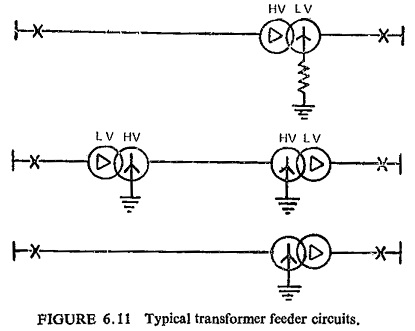Transformer Feeder Protection:
Transformer Feeder Protection – In order to supply bulk power from a major switching station, the transformer is sometimes connected directly to the feeder without an HV switchgear at the transformer. Although such a scheme provides considerable saving in the cost of switchgear but the problems of providing adequate protection are increased.
In addition to the protection provided for transformer and feeder when considered separately, the need for some means of intertripping between the HV and LV circuit breakers becomes essential.
Figure (6.11) shows typical transformer feeder circuits. There are two basic systems of protection which can be used for the transformer feeder protection, viz. unit and nonunit systems. Unit systems employ differential schemes which may be applied either separately for the transformer and the feeder or as an overall unit protection, combined for both the transformer and the feeder.
In both the cases a pilot wire channel is required. In the former to provide a means of intertripping and in the latter as an integral part of the scheme. Nonunit systems provide backup protection for faults outside the protected zone in addition to clearing the in-zone faults.
Overall unit protection offers the advantage that CTs on the HV side of the transformer are not required, but this is at the expense of a reduction in sensitivity and speed of operation in comparison to separate unit schemes unless additional relays are used.
Separate unit schemes are definitely the best form of protection but usually a nonunit scheme for the feeder combined with a unit scheme for the transformer provides adequate protection at a reduced cost.
